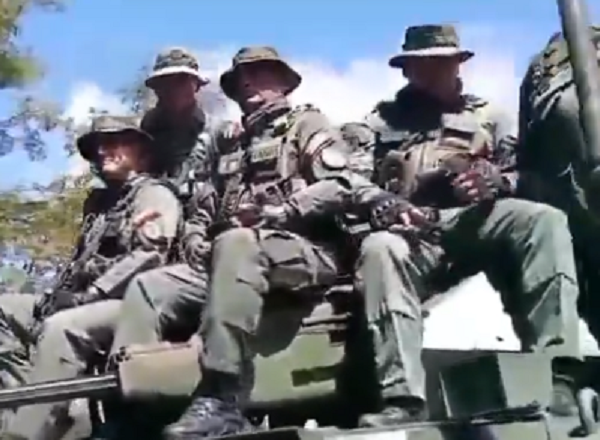Venezuela’s military is currently “backing up its threats to … secure access to some of the world’s largest oil finds in more than a decade by moving light tanks, missile-equipped patrol boats and armored carriers to the two countries’ border in what is quickly turning into a new security challenge for the Biden administration.”
The satellite images, which were shared by Venezuela’s military on its social media accounts, unveiled the recent military deployment on Friday. As highlighted in a December report by CNN, the border between Venezuela and Guyana was established by international arbitrators in 1899.
However, due to the recent oil discovery and the dire state of Venezuela’s economy under Nicolás Maduro’s socialist government, Caracas has disregarded the 125-year-old arbitration ruling. The Associated Press reported that Maduro’s government succeeded in an internal referendum to annex Essequibo in December, although the low turnout indicated a diminishing influence and a lack of responsiveness to the people’s needs.
“Venezuela’s National Electoral Council on Monday reported participation in the referendum of about 10.5 million voters, which would have been just over half of the 20.6 million eligible people. But those figures defied what people witnessed at voting centers, where long lines typical of Venezuelan elections never formed,” the AP reported.
Despite the fact that Venezuela possesses 130,000 front-line troops in comparison to Guyana’s total of 3,000 troops, it is evident that Guyana is significantly outnumbered. Furthermore, the United States has made a commitment to provide assistance through joint exercises shortly after the referendum: “In collaboration with the Guyana Defence Force (GDF), the U.S. Southern Command (USSOUTHCOM) will conduct flight operations within Guyana on December 7,” the U.S. Embassy announced.
“This exercise builds upon routine engagement and operations to enhance security partnership between the United States and Guyana, and to strengthen regional cooperation,” it continued, adding that “USSOUTHCOM will continue its collaboration with the GDF in the areas of disaster preparedness, aerial and maritime security, and countering transnational criminal organizations.
“The U.S. will continue its commitment as Guyana’s trusted security partner and promoting regional cooperation and interoperability.”
That dedication might soon face a challenge. As per the satellite images acquired by the Center for Strategic and International Studies, Maduro is strengthening his military presence in Essquibo and the adjacent waters.
NEW: Recent activity identified by CSIS experts in satellite imagery and social media shows concerning military activity from Venezuelan armed forces in the disputed Essequibo territory and nearby waters.
Read the breaking analysis from @CSISAmericas: https://t.co/zJsJuBgNae
— CSIS (@CSIS) February 9, 2024
CSIS’ report on Friday revealed that during the bilateral talks between Venezuela and Guayana in Brasília, the capital of Brazil, on January 25th, Venezuela had been actively strengthening its military presence on Anacoco Island in the preceding weeks.
“The island, awarded to Guyana as part of an 1899 arbitral award but seized and administered by Venezuela since 1966, has long been a point of tension between the two countries. A video, linked to the Bolivarian National Guard dated January 15, 2024, shows a staging area across the Cuyuni River from Anacoco Island where construction materials are piled up.
“Three armored vehicles, likely V-100/150 Commando amphibious armored personnel carriers (APCs) are also visible in the staging area. Maxar satellite imagery of the area from January 13, 2024, also shows the APCs, construction materials, a heavy river ferry and the clearing of a new area to the north, likely where Venezuelan military engineers intend to build a Mabey Compact 200 bridge to the island.”
“More recently, videos shared from Venezuelan military and government social media accounts on January 24 and 25 (the day of the meeting in Brasília) show an exercise taking place on Anacoco under the supervision of General Domingo Hernández Lárez, commander of the Strategic Operational Command of the National Bolivarian Armed Forces (FANB), who reports only to President Maduro and Defense Minister Vladimir Padrino López,” CSIS reported.
? #Enterate || El GJ Domingo Hernández Lárez, Comandante Estratégico Operacional de la FANB, pasó revista a la Isla de Anacoco en el estado #Bolívar con el fin de inspeccionar la construcción del tankódromo (parque de tanques), impulsado por la 11 Brigada Blindada junto al… pic.twitter.com/zKzjZYcxBf
— Ejército Bolivariano (@somos_ejercito) January 25, 2024
“Another earlier video from January 19 explains that what is being built on Anacoco Island is a jungle tank base with a 3.8-kilometer track (2.3 miles) with 14 obstacles, which will be used to train Venezuela’s armored units,” the report continued.
“The highly produced videos and coordinated social media campaigns suggest that the FANB is actively displaying its activities on Anacoco as part of an information operation. With videos boosted relentlessly by military social media networks featuring logos, music, and editorial flourishes, the Venezuelan armed forces are intentionally crafting a message for external consumption, with one key audience being the Guyanese government.”
#IngenierosPorVenezuela?El @6TOCING_EJB Cumpliendo instrucciones del @CEOFANBVE desde la Isla de Anacoco, edo Bolívar; continúan los trabajos de Ingeniería a orillas del río Cuyuní, donde se construye el puente Mabey Compact 200 y la construcción del tancodromo en selva. pic.twitter.com/Kga4qfL46n
— @6TOCING_EJB (@6TOCING_EJB) January 19, 2024

